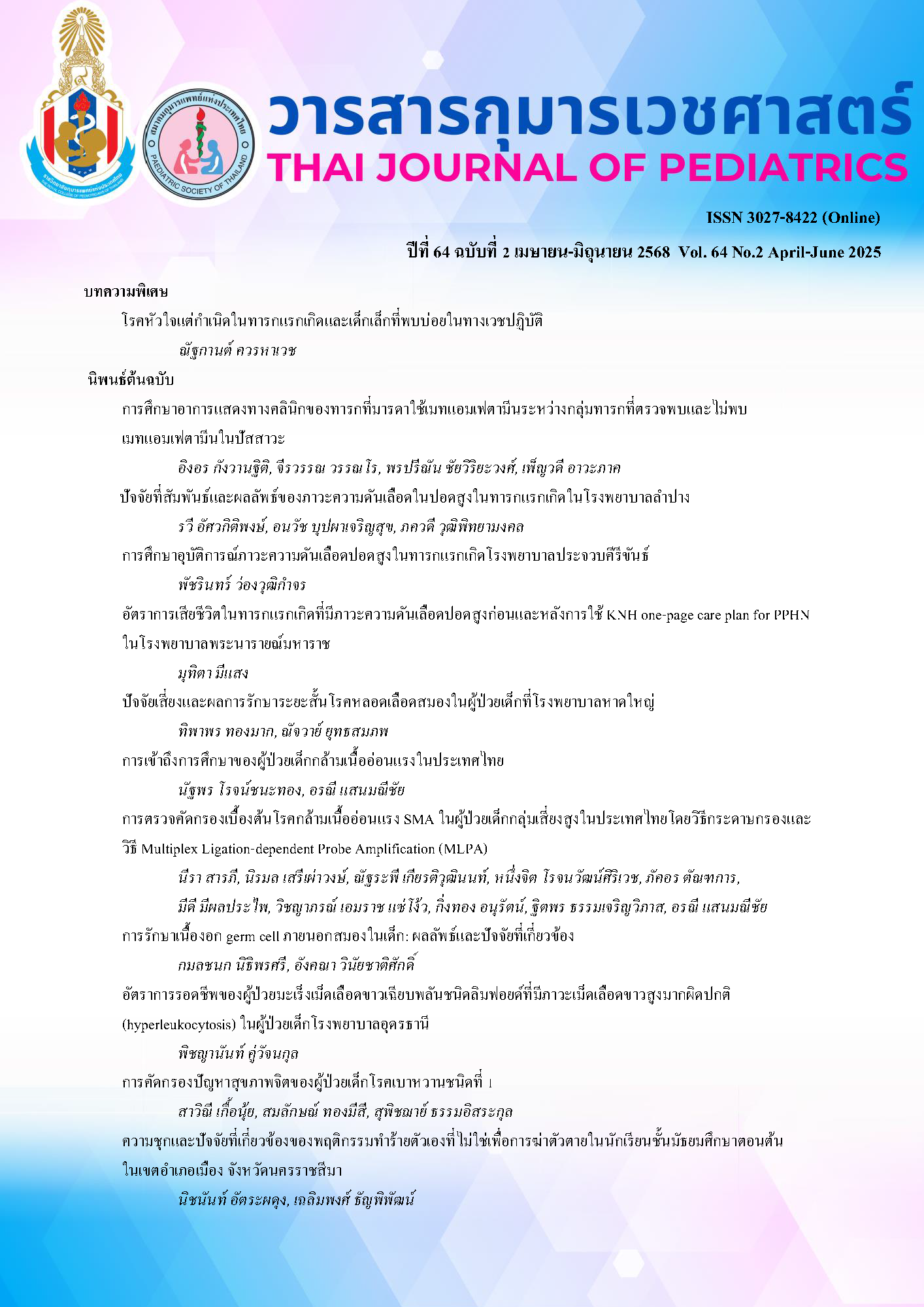Risk factors and short outcome of pediatric cerebrovascular diseases at Hatyai Hospital
Keywords:
pediatric stroke, stroke outcomeAbstract
Background: Pediatric stroke is uncommon; however, it has the developmental consequence. It is classified into two categories: Ischemic stroke and hemorrhagic stroke, each with distinct risk factors.
Objective: This study aimed to evaluate the risk factors and outcomes of pediatric stroke by using the Pediatric Modified Rankin Scale (MRS), at discharge and at a three-month follow-up.
Method: A retrospective study was conducted involving children aged 28 days to 15 years diagnosed with stroke between January 1, 2011, and December 31, 2021, at Hat Yai Hospital, a tertiary care center in southern Thailand. The study analyzed baseline characteristics, clinical presentations, risk factors, and outcomes at discharge and a 3-month follow-up. Descriptive statistical analysis was performed to assess the data.
Results: Among the 50 children enrolled, 56% were male. Arterial ischemic stroke accounted for 60% arterial hemorrhagic stroke for 32% and cerebral venous sinus thrombosis for 8%. The most common presentation in arterial ischemic stroke was weakness, whereas altered consciousness and nausea with vomiting were more common in arterial hemorrhagic stroke. Arterial ischemic stroke, heart diseases, meningitis and idiopathic were the common risk factors whereas thrombocytopenia and sepsis, and unknow cause were risk factors of hemorrhagic stroke. Infection was the most common risk factor in cerebral venous sinus thrombosis. The overall mortality rate of pediatric cerebrovascular diseases was 28%. Many survivors experienced significant disabilities.
Conclusion: Arterial ischemic stroke was the most common type of stroke in children, with risk factors varying across cerebrovascular disease groups. Pediatric stroke remained associated with high mortality and a considerable burden of disability.
Downloads
References
Tsze DS, Valente JH. Pediatric stroke: A review. Emerg Med Int. 2011;2011:734506.
Lehman LL, Khoury JC, Taylor JM, Yeramaneni S, Sucharew H, Alwell K, et al. Pediatric stroke rates over 17 years: Report from a population-based study. J Child Neurol. 2018;33:463–67.
Ferriero DM, Fullerton HJ, Bernard TJ, Billinghurst L, Daniels SR, DeBaun MR, et.al. American heart association stroke council and council on cardiovascular and stroke nursing. management of stroke in neonates and children: A scientific statement from the American heart association/American stroke association. Stroke. 2019;50:51-96.
Dlamini N, Kirkham FJ. Stroke and cerebrovascular disorders. Curr Opin Pediatr. 2009;21:751-61.
Numis AL, Fox CK. Arterial ischemic stroke in children: risk factors and etiologies. Curr Neurol Neurosci Rep. 2014;14:422.
ภิรดี สุวรรณภักดี, ชาครินทร์ ณ บางช้าง, ชาญชัย ไตรวารี. Childhood stroke classification and role of anticoagulant. เวชสารแพทย์ทหารบก. 2010;63:163-72.
Visudhiphan P, Chiemchanya S, Wattanasirichaigoon D. Strokes in Thai children: Etiology and outcome. Southeast Asian J Trop Med Public Health. 1996;27:801-5.
Auvichayapat N, Tassniyom S, Hantragool S, Auvichayapat P. The etiology and outcome of cerebrovascular diseases in Northeastern Thai children. J Med Assoc Thai. 2007;90:2058-62.
Samerton P, Paibool W, Komviliaisak P, Wongmas P. Childhood arterial ischemic stroke in a teritiary care center, Northeastern Thailand. Thai Journal of Pediatrics. 2020;59:299-304.
Ganesan V, Hogan A, Shack N, Gordon A, Isaacs E, Kirkham FJ. Outcome after ischemic stroke in childhood. Dev Med Child Neurol. 2000;42:455-61.
Kornfeld S, Studer M, Winkelbeiner S, Regényi M, Boltshauser E, Steinlin M; Swiss neuropediatric stroke group. quality of life after paediatric ischemic stroke. Dev Med Child Neurol. 2017;59:45-51.
Gumer LB, Del Vecchio M, Aronoff S. Strokes in children: A systematic review. Pediatr Emerg Care. 2014;30:660-4.
Vyas S, Vaswani RK. A study of risk factors and clinical outcome of stroke in children. Int J Contemp Pediatr. 2019;6:1439-44.
Fatema K, Rahman M. Risk factors, clinical characteristics, and outcomes of recurrent pediatric stroke: A study from Bangladesh. J Pediatr Neurosci. 2022;17:46-53.
Pangprasertkul S, Borisoot W, Buawangpong W, Sirikul W, Wiwattanadittakul N, Katanyuwong K, et al. Comparison of arterial ischemic and hemorrhagic pediatric stroke in etiology, risk factors, clinical manifestations, and prognosis. Pediatr Emerg Care. 2022;38:1569-73.
K-L Chiang, C-Y Cheng, Epidemiology, risk factors and characteristics of pediatric stroke: A nationwide population-based study. QJM. 2018;111:445-54.
Lo W, Stephens J, Fernandez S. Pediatric stroke in the United States and the impact of risk factors. J Child Neurol. 2009;24:194-203.
Boulouis G, Blauwblomme T, François Hak J, Benichi S, Kirton A, Meyer P, et.al. Nontraumatic pediatric intracerebral hemorrhage. Stroke. 2019;50:3654-61.
Wang X-H, Zhang L-M, Chai Y-M, Wang J, Yu L-F, Zhou S-Z. Clinical characteristics and outcomes of pediatric cerebral venous sinus thrombosis: An analysis of 30 cases in China. Front Pediatr. 2019; 7:364.
Downloads
Published
How to Cite
Issue
Section
License
Copyright (c) 2025 The Royal College of Pediatricians Of Thailand

This work is licensed under a Creative Commons Attribution-NonCommercial-NoDerivatives 4.0 International License.


